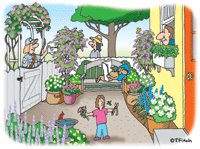 Gardens play many roles in our lives. They’re sanctuaries and playgrounds, habitat for wildlife and colorful backgrounds for entertaining. They can also be aromatic portals to our past.
Gardens play many roles in our lives. They’re sanctuaries and playgrounds, habitat for wildlife and colorful backgrounds for entertaining. They can also be aromatic portals to our past.Nothing conjures up long forgotten memories like our sense of smell. A whiff of lavender and we remember our father’s aftershave or a great-aunt’s parlor. And so, with just a shovel and a shrub, you can open a pathway to your past – or perhaps create some fragrant new experiences.
In many ways, a fragrance garden is a unique place which is as much a part of the heart as the yard. In fact, you don’t even need a yard! A handy window box or balcony planter can become home to an unparalleled array of aromas, both floral and culinary.
Imagine reaching out your kitchen window and lightly brushing against the fuzzy foliage of scented geraniums (Pelargonium spp.), their leaves perfumed with rose and lime, appetizing pineapple, and spicy ginger and nutmeg. But don’t stop there, those fragrant leaves can also be used to flavor homemade jellies, create potpourris, or sachets for stale drawers and closets.
You might also choose to fill your window-hugging planters with other fragrant annuals, such as sweet alyssum or colorful petunias, peppery nasturtiums, and so many more, all of them readily spreading their scent into your home with each passing breeze.
Decorative planters used on patios or throughout your garden can also provide a home for perennial plants which are too tender to overwinter outdoors. These include the fragrant foliage of lemon verbena, and the intensely perfumed flowers of common gardenia, and both angelwing and Arabian jasmine (J. nitidum and J. sambac).
Container cultivation is also a wise choice for somewhat rambunctious plants, like lemon balm or most members of the mint family. Planted in a garden bed, these fragrant delights soon become horticultural hoodlums and crowd out any other plant not belonging to their gang.
And unless one is planning to build an “Orangery” or conservatory, containers are the best environment in which to enjoy the scented flowers, foliage, and fruit of the citrus family, including several species of dwarf orange, as well as Kaffir and Thai lime, and popular dwarf lemon varieties such as Lisbon, Eureka and Meyer.
Around your garden, it’s often handy to plant species with fragrant foliage around seating areas, where you can easily reach over and brush or bruise the leaves. For a classic touch, consider enclosing your garden seat with a variety of clean-smelling and colorful lavenders or warm-scented rosemary. And while some scents are subjective, I have loved the aroma of English boxwood since childhood, as well as juniper, although some people find both musty and even unpleasant.
Actually, culinary herbs like sage and thyme, in addition to rosemary and lavender, are wonderful and traditional additions to any fragrance garden. Plant them around a bench or use them as an edging plant along narrow pathways where you’re likely to brush against them. Paths can also be lined with aromatic herbs used as groundcovers, such as silver mound artemesia (wormwood), dusty miller, and sweet woodruff (Galium odoratum).
Of course, some garden scents will come to you without coaxing, such as the aroma of flowering tobacco (Nicotiana), vanilla-scented heliotrope, clove-scented stock (both the common and night-flowering varieties), and members of the Dianthus family, including the varied hues of carnation, sweet william, and cottage pinks.
And don’t forget to add color and fragrance to your spring garden, perhaps a time when you need it most! Some of the best spring bulbs include both hyacinth and grape hyacinth, narcissus, and an old-fashioned favorite, lily-of-the-valley (Convallaria majalis).
The fragrance garden should also include a number of small trees and shrubs, such as mock orange (Philadelphus coronaries) or the petite daphne (D. mezereum), one of the earliest and sweetest-flowering shrubs available.
Of course, the cherished champions of fragrance are the lilacs: the Syringa species. Lilacs provide cascading blooms in creamy white, sky blue, pinks, yellow, and intense purple, among others. Be sure to look for mildew or fungal resistant varieties when making your selection.
There are two native species of note which combine hardiness with beautiful white flowers and a butterfly-entrancing fragrance: globe-flowered buttonbush (Cephalanthus occidentalis) and sweet pepperbush or Summersweet (Clethra alnifolia) whose creamy white buds seem synonymous with the gentle warmth of May. For variety, you might also seek out a newer cultivar C. Rosea which offers delicate pink blooms as well as fragrance. The above are all readily available in most nurseries and provide an environmentally-sound alternative to the overly popular butterfly bush or Buddleia, which is fast becoming an invasive species in our ecosystem, particularly the cultivars ‘Black Knight.’
You should consider using a trellis or arbor to support vines to entice and envelope you. Treat yourself to night-blooming moonflower, native wisteria, bright-colored sweet peas, or soft-scented and autumn-blooming virgin’s bower (Clematis virginiana).
Naturally, we cannot talk about fragrance without mentioning roses. Unfortunately, 20th century hybridization has left the rose somewhat de-scented, especially among climbers and the popular hybrid teas. When searching for a rose, by any other name, it’s best to look for varieties known as “antique” or “old-fashioned.” Or you could just sniff your way to a winning selection by visiting a local rose garden.
Copyright 2009, Joseph M. Keyser



No comments:
Post a Comment